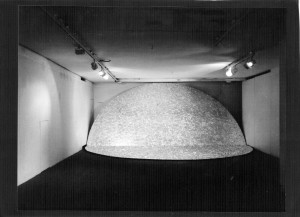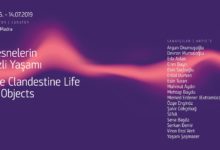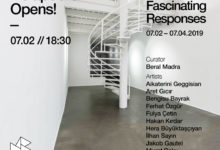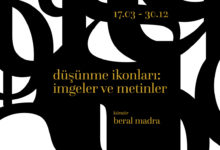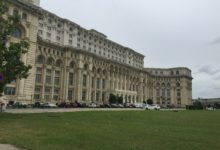Catalogue text for the Exhibition of Dmitri Alithinos in the Greek Pavilion, Venice Biennale, 1997
What Dimitri Alithinos cannot conceal?
Without her you would never have taken the road.
But she has nothing more to give you
And if you find her poor, Ithaca has not defrauded you.
With the great wisdom you have gained, with so much experience,
You must surely have understood by then what Ithaca mean.
C.P. Cavafy (1)
I met Dimitri Alithinos in Bari in 1989, two days before the opening of the exhibition Mediterraneo per l’ Arte Contemporenea, organised within the Expo-Arte. I was desperately waiting for the works of the Turkish artists to be delivered to the exhibition hall while the other curators and artists from several Mediterranean countries were already busy installing their works. The curator of the Greek exhibition Efi Strousa and Alithinos with whom I became mutual friends were the ones who comforted me. Alithinos was working with silent determination and austerity but he was also dispelling this seriousness with humor and irony. Out of his many cargo boxes pure white bodies were emerging. After several hours they were lined along the wall. A procession of modern curoi, an archaic ceremony appeared in the context of the exhibition.
The plaster cast bodies were “born out of the combination of his body and spirit”, as Strousa describes them. The bodies were headless, their arms and hands were bent forward in a praying gesture. This movement of the hands were manifesting latent and potential meanings. Alithinos’ evidently representative statues were of an enigmatic kind which made the observer to accept them as unrepresentative works. They demanded the viewer to approach them as pure and as naked as themselves and to participate in the transformation of the physical energy into conceptual and spiritual energy during this confrontation. The headlessness of the bodies provoked this spirituality. One could think that the spiritual energy planted in the absent heads of the bodies I saw in Bari was concealed somewhere to be searched after or to be found in the future. This ambiguously abstract quality might only be compared to or experienced when viewing the aniconism of Islamic art.
Later, when we worked together I learned to connect this representative work to his other works, specially to the concealment series, which are in fact invisible and transcendent.
Alithinos started to conceal works in 1981. Ten years later, after many concealments all over the world, he was given the opportunity to make one of his concealments in Istanbul which was not only one of his numerous localities on his map of concealments but also a significant reference point to his ancestors and to his roots which he wanted to explore.
The realization of this particular concealment consisted of some intricate stages. The first stage being the most facile has been realized in Gallery B.M. (2) Together with one of the most virtuous artisans in Istanbul he cut and welded a 6 m diameter iron disk and instaled it in to the gallery space. Alithinos later worked for long hours to cover the disk with shimmering silver foil. At the same time he instaled a small disk into a circular opening on the opposite wall. Alithinos preferred a form which was symbolic, primordial and archaic. The disks emanated rhetoric and objectiveness. He united the reductionist character of minimalism with the abundant splendor of fetishism.
The disks were exhibited from 8th May to 15th of June 1991 during which time we presented the concealment project to the Municipality of Istanbul. Although the bureaucratic apparatus was slow and ponderous we were given a place in a public park in Maηka which at that time was being constructed into an recreation area. Later this park was named “Maçka Democracy Park”. A curious incident happened during the excavation of the 6,5 X 6,5 m large and 4,5 m deep trench. A marble statue of a lion appeared out of the soil and debris that had accumulated during the last two decades. The statue was not older than half a century, as remembered by the people standing around the excavation area and mysteriously disappeared soon after it was found. The disk was transported from the gallery into the trench and covered with earth in front of the public. Alithinos’ work in Gallery B.M. and Maηka Park was related to his major concealment work in Patras which he had executed earlier that year in Epikentro Gallery.
The positive reception of Alithinos’ work and the enthusiasm of the public in Istanbul opened a path for artistic and cultural communication and collaboration between the art scenes of Greece and Turkey. He was one of the fourteen artists who participated in the exhibition “SANAT, TEXNH” realized in March 1992 in Istanbul (3). At first his project for this exhibition seemed almost as unrealizable as his Macka park concealment, as he was intending to cover a wall of 256 m2 with silver foil. The wall in the garden of Dolmabahηe Palace was preserved under the law of conservation of historical monuments, however that part of the palace was being restored and we were allowed to use the wall for this exorbitant project. Alithinos covered the wall with silver foil and entitled the work “Future Concealments”. Upon the requests of the visitors this work was presented a couple of months after the exhibition.
Once in an interview Alithinos told me a story which indicated that Istanbul should be considered as one of the few milestones in his journeys to the diverse parts and cities of the world: Once he went to an island and met an old man. He asked him how he could go to Athens and from there to New York. The old man replied that he would first have to travel eastwards and then reach the West. Alithinos told me, “to me traveling eastwards means going towards the light; east is Istanbul, Karachi, Calcutta, Tahiti, New York. The East is not a geographical concept for me, only a journey towards the light. One day I may find America by traveling towards the light; now I am still traveling within this light”. Then he implied that the island was in the Pacific Ocean. “Future Concealments” was a work where one could effortlessly comprehend the concept of the artist. The sun light not only changed the shimmer from silver to gold and reflected the energy but also displayed the process of transformation of a solid surface into a light source.
Later, in 1994, when we met in Bologna he was hanging the framed post-cards which indicated the localities of his concealments on the exhibition wall. There I detected the direction of his journeys. During his last visit to Istanbul in summer 1996 I learned that he found America in Tierra del Fuego.
The description of these concealments evokes many ideas concerning the art works produced for open air or official spaces. I particularly remember the words of Rosalind Krauss in her 1987 article “Sculpture in the Expanded Field”: “Thus the field provides both for an expanded but finite set of related positions for a given artist to occupy and explore and for an organization of work that is not dictated by the conditions of a particular medium…”(4).
The expanded field of Alithinos’ work, is a vast geographical-historical-cultural territory. In this field Alithinos shifts position on all directions, never giving up his permanent and resolute situation suspended between these different fields. He explores and occupies many lands within this field and organizes a work which is exposed and concealed, visible and invisible, material and spiritual at the same time. He liberated himself from the production, exposition and commercialization of the work and enabled himself to dictate conditions upon the viewer and the art system. Any medium could be employed for his concealments and any medium could document his concealments.
The alienation as well as the enormous presence were achieved by the dimensions and corporeality of the disks dominating the gallery space both in Epikentro and B.M. It was his intention to make the viewer exhaustively conscious of the missing potential when the work was later concealed. The silver foil contributed to the esthetic experience of the public and resolutely emphasized the fetishistic aspect of the work. Upon the loss of this aesthetic and fetishistic pleasure that the viewer will perceive after the concealment is the manifestation of the spiritual presence which initiates a myth.
Alithinos indicated the essential through the presence of the concealed and challenged the viewer with this cool and well calculated strategy. The viewer of Alithinos’ work is not like the viewer of a modern sculpture who observes the work from a distance. She is also not the post-modernistic viewer who has to move around or into the sculpture and adjust himself/herself into its contexts and conditions. Alithinos fulfilled the demands of the changing paradigm of the world culture and art by traveling to the remotest places, by carrying out the same performances, by distributing his work evenly and taking his share in exchange for what he has to offer. He is a globalist artist in every sense of the word. His viewer is a witness watching a process, which is not only a manifestation of authentic globalist concepts and attitudes but also the transformation of materiality to spirituality or energy. Lyotard’s words may be a keypoint to this action: “Material is not something which can be looked at and it is not like an object to be confronted by a subject. Scientific analysis of the material has shown that it is nothing more than a condition of energy, i.e. a connection of elements not tangible and determined by structures which have only a local validity” (5).
By operating between the two radically distinct worlds of art, the one being the objectiveness and materiality of sculpture, the other being the initial theory and conceptuality, Alithinos created an ambiguous experience of perception for the viewer. He made us thoroughly conscious of the missing potential of the art work, indicated the essential through the presence of the concealed, converted the conformity into antagonism.
Alithinios’ vision of rituals as he has witnessed in remote lands in the East and West, in the North and the South and his transposition to these territories seem to be fundamentally different from the expectations and requirements of the art world today. Hal Foster in his book “The Return of the Real” deals with the subject of distance, which explains the position of Alithinos. Foster speaks of spatiotemporal splitting, the paradox of immediacy produced through mediation and other splitting that occurs with new intensity today and brings forward the importance of the correct distance to one’s object with reference to Walter Benjamin’s words “Criticism is a matter of distancing” (6). Alithinos’ corpus of work is a criticism which enables the viewer to comprehend the concealed course of art as a process of decision on human fate. He provided this distance first by disengaging himself from the immediate requirements of the art system and then by employing a procedure which is based on spatial and temporal speculations incorporating past, present and future.
Beral Madra
Istanbul, April 1997
1.”Ithaca”, 1911, in The Complete Poems of Cavafy, Transl. By Rae Dalven, A Harvest Book, New York and London, 1976
2. Since 1991 B.M. Contemporary Art Center
3. “SANAT-TEXNH” Fourteen Turkish and Greek Contemporary Artists, curated by Efi Strousa, Beral Madra, MSU Painting and Sculpture Museum, Istanbul
4. Rosalind Krauss, “Sculpture in the Expanded Field”, in The Anti Aesthetic, Ed. Hal Foster, Day Press, 1991, p. 31
5. J. F. Lyotard, “Philosophie in der Diaspora”, in Immaterialitat und Postmoderne, Merno Verlog, 1985
6. Hal Foster, “The Return of the Real”, The Mit Press, 1996, p. 222
Arredamento Dergisi
Mayıs 1991
S. 132-133
DİMİTRİ ALİTHİNOS:
“SANAT ELEŞTİRMENİ PAPAZIN YERİNE GEÇTİ.”
Çağdaş Yunan sanat ortamının önde gelen eleştirmen ve küratörlerinden Efi Strausa, 1989’da Bari’de (İtalya) Expo Arte kapsamında gerçekleştirilen “Akdeniz Ülkeleri Çağdaş Sanat Sergisi” katalogunda, Yunan sergisiyle ilgili yazısında şunları söylüyordu: “…tarihle kararlı bir bağlantı kuran bu çıkışın farkında mısınız? Yüzyıllar boyunca insanın tarihsel kavramını ve gelişimini besleyip yayan dünyanın bu bölgesinde (Akdeniz), bu soru bir kez daha gündeme geliyor. Sanat, bu düşünce silsilesini tamamlamak, ve tarihsel zaman dışında kalan yaratıcılık gizlerinin içine girmeye olanak tanıyan arkaikliğe ulaşmak üzere. Tarih kör ve ideolojik bağları zorla kabul ettirirken, sanat bunların üstesinden gelmeye çalışıyor ve bugünkü bilgilenme sistemine boyun eğmeden, gerçekle ilişki kurma görevini sürdürüyor. Bu yüzyılda bu yönde değinmeler ve aydınlatıcı beklentiler yaşadık. Yol keşfedildi; ama bu, uzun ve yavaş olacak. Bu, çağdaş üretimin değil, bir kuluçka ve büyüme sürecinin hızıdır.”
Efi Strousa’nın Expo Arte için seçtiği sanatçılar arasında, kendi gövdesinden kalıp alarak, bunları bir dizi alçı-heykele dönüştüren Dimitri Alithinos da bulunuyordu. Figürlerin başı yoktu; ama gizemli ve büyülü jestlerle uzanan elleri derin bir bekleyişin ve sabrın göstergesiydi. Bu, insanlar arasında günümüz dünyasında varolmayan gerçek ilişkinin kurulmasına bir çağrı anlamına geliyordu. Figürler, arkaik kurosların yeni bir tarih ve kültür yaratmak üzere ileriye doğru adım atışlarını ve bunu yaparken geçmiş ve geleceği aynı anda kavrayan bilgelik dolu gülümseyişlerini gündeme getiriyordu. Alithinos’un heykellerinde baş yoktu; ama biz, bu gülümsemeyi görüyorduk sanki.
Dimitri Alithinos, “2.Uluslararasi İstanbul Bienali” kapsamındaki -yine Efi Strousa’nın küratörlüğünde düzenlenen- Yunan sergisine bu kez, bal petekleriyle donatılmış iki araba arasında karşılıklı yayılan, paslı desenlerle süslü, yıldız biçimli iki demir disk sergiledi. Bu yapıt da arkaik bir enerjinin, tüm insanlığın paylaştığı ama adlandırmaya zaman bulamadığı “tasavvufi” düşüncelerin varlığına değiniyordu.
1945, Atina doğumlu Alithinos, sanat ortamında adını 70’1i yılların başında duyurdu. Atina’nın avant-garde galerisi Desmos’da açtığı sergilerle dikkat çekti. 80’li yıllarda Paris (Gençlik Bienali), Amsterdam, Antwerp, Sao Paolo (17.Bienal), Stockholm, Atina ve Lefkoşe’de karma sergilere katıldı. Atina’da yaşamasına karşın, sürekli dünyayı dolaşan ve özellikle Afganistan ve Hindistan’a giden Alithinos, karşılaştığı farklı kültürel ve toplumsal ortamlarla doğayı, belirli bir anlatım dilinin kısıtlayıcı biçimciliğine kapılmadan yorumlamaya çalıştı.
Alithinos İstanbul’a bir kez daha, Mayıs ayında Galeri BM’de bir kişisel sergi gerçekleştirmek üzere geliyor. Türkiye’ye birkaç kez gelerek, ülkemizin kültürel, toplumsal ve doğal ortamını kendine özgü araştırıcılığı ve duyarlığıyla algılayan Alithinos yüzeysel ve görünenin albenisine -ya da iticiliğine- kapılmadan, altındaki gerçek ve gizemle ilgilendi. Aiithinos ile, sergisi öncesinde bir söyleşi yaptık -daha doğrusu, 1990 Haziranında Girit Bienali öncesinde uğradığımız Atina’da başladığımız konuşmaları sürdürdük.
Ancak, bu konuşmayı aktarmadan önce, Atina’daki çağdaş sanat ortamının durumuna değinmemiz gerekiyor. Ulusal Müzesi içinde bir modern sanat müzesi bulunan Atina’da, kapsamlı bir çağdaş sanat müzesi yok; ama birkaç özel çağdaş sanat müzesi bu gereksinime yanıt verebiliyor. İstanbul’da olduğu gibi, Atina’da da çağdaş sanatı ayakta tutma işlevini galeriler görüyor. Küratörlük sistemi gelişmiş, sponsorlar az olmakla birlikte bilinçliler, uluslararası sanat pazarına girme amacını da benimsemişler. Yunanlı sanatçılar çoğu kez kendi çabaları ve uluslararası sanat ortamıyla ilişkideki Jean Bernier, Desmos, İleana Tunta gibi galeriler ve Dracos Art Center ve Dimitri Coromilas’in yayımladığı Tehni Art dergisi aracılığıyla, kendilerini özellikle Avrupa’ya tanıtma olanağı buluyor. Şimdilerdeyse, gerek sanatçılar, gerekse galeriler Avrupa Birliği içindeki konumlarını hesaplamakla meşguller. Hem umut, hem de çekingenlik egemen bu alanda. Alithinos şöyle söylüyor:
“Bugün Yunanistan 1992’ye hazırlanıyor, her şey bu yeni sisteme uydurulmaya çalışılıyor. Ben ise kendimi XXX.yüzyıla hazırlıyorum. Resimlerim ve yapıtlarım XXX.yüzyıl için! Yunanistan için bu hazırlık aşamasında bazı şeyler kötü, bazı şeyler iyi. Kötüleri sıralayayım -gerçi Avrupa Birliğine girince siz de göreceksiniz: Avrupa’nın güçlü devletlerinin kültürleri birbiriyle rekabet içinde. Bu rekabeti sürdürebiliyorlar; çünkü, temel yapıların hepsi var onlarda. Bize kendi ölçütlerini kabul ettirmek istiyorlar; oysa, biz eşit durumda değiliz. Ekonomik, siyasi ve toplumsal altyapıda olduğu gibi, sanatsal altyapıda da eşitlik yok. Biz görünüşte güçlü değiliz, ama gizli bir biçimde güçlüyüz. Bizde derin bir yaratıcılık var; sanatı duyarak yaşıyoruz biz, onlarsa sanatı üretmiyor. Arada çok büyük bir fark var. Avrupa kültürüne inanmıyorum. Avrupa küçük kültür bahçelerinden oluşmuş bir büyük bahçe. Onların suyu var, suluyorlar; benim bahçemin suyu yok, solmuş bir bahçe benimki. Önce bunu onarmalıyım.
“ABD kültürü çok-yönlü, ama icat edilmiş bir kültür. Boston’da 1883 tarihli yapılar “en eski” sayılıyor. Onlar tarih ve kültür yaratmaya, sonra da bize satmaya kalkışıyorlar. Gerçek kültür ve sanatın sahibi bizlerin bu baskılara karşı koymamız ve kimliğimizi onlara kabul ettirmemiz gerekli. 1992’de Avrupa kentlerinde yaşamak gibi birtakım kolaylıklar belki olacak, ama kuşkuyla bekliyorum.”
Avrupa Birliği’nin yürürlüğe girmesi aşamasında yapılan hazırlık ve bilgilenme seviyesi nedir?
Dimitri Alithinos: Gecen Eylül OMEPA adlı sanat sponsorluğu örgütü tarafından bir uluslararası sempozyum düzenlendi. Bu sempozyuma Avrupa’dan ve Japonya’dan küratörler, özel şirketlerin sanat danışmanları, halkla ilişkiler uzmanları ve reklamcılar katıldı. Bizi aydınlatmaya çalıştılar. Anlaşılan, artık sponsor kişiler yok, sponsor firmalar var; başka bir deyişle, geçmiş dönemin ‘mesenleri’nin yerini anonim şirketler aldı. Bu şirketleri “çok kültürlü” danışmanlar yönlendiriyor. Bu sempozyumda. kuruluşların sanat eleştirmeni kullanmalarını önerdim. Bence sanat eleştirmenlerinin işlevi çok önemli, nedeni de çok açık! Sanat eleştirmenleri sanatçıların sadık dost gereksinimini karşılıyor, onların pratik işlerini görüyor, ilişkilerinde yardımcı oluyorlar. Benim için sanat eleştirmeninin işlevi Rönesans’tan bu yana değişmedi. Rönesans’ta sanatçı kilisede çalışırken papazla ilişki kuruyordu; papaz, sanatçının sırdaşı, ortağıydı. Günümüzde sanat eleştirmeni papazın yerine geçti. Örneğin Efi Strousa benim için bu anlamı taşıyor.
80’Ii yıllar bütün ülkelerde, sanatta değişmelerin, metaforların dönemi oldu. Yunanistan’da 80’ler nasıl geçti?
D.Alithinos: 80’1i yılların başında Yunanistan’da Efi Strousa’nın adını koyduğu bir akım var: “Emerging images” (Doğan İmgeler). Ben, Diochandi, Lazongas, Davou gibi sanatçılarla birlikte bu akımın içindeydim, ama 85’den sonra ayrıldık. Biz “transavanguardia”ya karşıydık, çünkü bu akım biraz prefabrike geliyordu bize. Oysa, “arte povera’ bir gereksinimden doğmuştu, organik gelişme kökleri vardı. Transavanguardia sanki önceden hesaplanmıştı, başka bir deyişle, “Şimdi böyle bir akımın zamanıdır denilerek yaratıldı.
Benim özelliklerimden biri, ileriyi görmek; bu örnekte bunu yaşadım. Prefabrike akımların ilki “transavanguardia” idi, daha sonra bunu “neo-geo” gibi akımlar izledi. “Bu prefabrike akımların ne sakıncası var?” diye soracaksın. Sakıncası var; çünkü zorla kabul ettirme durumu var. Organik olmayan bu akımları yalnızca bizim gibi periferal ülkelerin sanatçılarına değil, kendi sanatçılarına da kabul ettirmek istiyor bu sanat sistemcileri. Müzeleri, galerileri, altyapıları olduğu için de kabul ettiriyorlar. Olanakları olmayanlar bu yapaylığa kurban oluyor, Yunan ve Türk sanatçılar gibi. Her iki ülkede de 20’şer müze olsaydı, durum değişik olurdu.
Oysa, sanat ye kültür zaman ister. “Ready-made” kültür olmaz. Şimdi, “bu yılın sanatı” diyoruz, geçmiş için “yüzyıl” birimi kullanıyoruz. Ne büyük bir çelişki ve aymazlık! Büyük ülkelerde bu akımlar bitse bile, küçük ülkelerin sanatçıları aynı akımlar kapsamında hala üretiyorlar. Bu doğru değil; tam zamanı vardır ve buna saygı göstermek gerekir. Sanatçı bu zamana bağımlıdır. Zaman yapıtın tamamlayıcısıdır. Bu zaman yoksa, yapıtı tamamlama olanağı yoksa, sanatçı karanlıktadır.
Bu durumda senin direncin nasıl oluşuyor?
D.Alithinos: Benim yarattığım ve yaratacağım bütün yapıtları içimde taşıyorum. Benim içimde bir ışık var; bu ışığı kendi içimdeki, yapıtları taşıyan derinliğe doğru döndürürsem, yapıtlarımı görürüm. Eğer, bir sanatçının kendi içindeki ışığı, kendi içindeki yapıtlara doğru döndürme olanağı yoksa, bu kötü! Bence büyük ülke sanatçılarının da ışığı var; ama onlar bu ışığı kendi içlerine döndürme olanağı bulamıyorlar, ya da bu riske girmek istemiyorlar. .Olanakları yeniden oynatmak korkusu bu. Işığı döndürmeye başlayınca risk başlıyor, karanlığa rastlarsam korkusu bastırıyor; ye onlar ışığı hep aynı yerde tutmayı yeğliyorlar.
Ben Ayasofya’yı, Sistin Kilisesini vb. kendim yaptığıma eminim. Buna metafizik deniliyor, ama bu bence fizik. Benim gücüm biraz da bundan kaynaklanıyor. Benim müşterim bu sistem değil; sistemin kölesi olmuyorum.
Doğu kavramı sizin için önemli. Sizce Doğu nedir?
D.Alithinos:Bir gün bir adaya gittim ve yaşlı bir adamla konuştum. Bana buradan sonra nereye gideceğimi sordu, “Atina ve New York” dedim. “Demek Batıya. sonra da Doğu’ya gidiyorsun” dedi. Benim için Doğu, ışığa doğru gitmektir. İstanbul, Karaçi, Kalküta, Tahiti, Amerika. Doğu, benim için coğrafi bir kavram değil, sadece ışığa doğru gitmek. Bir gün Amerika’yı ışığın yönüne doğru giderek bulacağım, şimdi ise bu ışığın içindeyim.
Bu ada Pasifik Okyanusu’ndaydı! Bu, benim içimde olduğunu söylediğim ışıkla aynı şey. Ben, bir ülkede seyahat ederken toplumsal yaşamla ilgilenmem. Toplumbilimci değilim. Bir öğrenci gibiyim, bu nedenle içimdeki ışığı sürekli döndürebilmek için çok olanağım var.
Java’da, bir kapının yanında birbirine benzeyen iki heykel vardı. Biri kötüyü, öteki iyiyi simgeliyordu. Oysa, çok dikkatli bakıldığında birbirinin aynıydı; ak ve kara değildi yani. Eşit iki şey nasıl iyi ve kötü olurdu? Birden ayrı pozisyonları anladım. Biri bu yanda, öteki öte yandaydı. Bizler için kesin karşıtlıklar var, oysa Doğu’da yaşayanlar için bu karşıtlık yalnız yer değiştirmeyle oluyor. Bu, içinizdeki ışığı değiştirebilmeniz için yeterli bir olanak. Oysa, Batıda böyle değil. İyi, kötüden başka bir şeydir. Ya iyisin, ya da kötü! Ya sistemin içindesin, ya da değil!
Haziran 1990’da “Epidauros Festivali”nde gerçekleştirdiğiniz yapıt bu felsefenizi yansıtıyor. Bir galeninin tabanını 3.5 m. derinliğinde kazdırdınız ve 6 m. çapında, üstü gümüş kaplı bir kalkanı bu büyük çukurda sergilediniz ve sergiden sonra bunun üstünü örtüp, kalkanı belki sonsuza değin sakladınız. Olağanüstü güçlü bir iş bu!
D.Alithinos: Evet, bu yapıtı saklarken, sözünü ettiğim gerçeği bu denli çıplak görmüyordum. Bu saklama işini, bir tohum ekme gibi görebilirsiniz. Bu yapıtta birkaç özellik var: Geçmiş, şimdiki zaman ve geleceği birarada düşünüyor, yapıtın biçimini görünmez kılıyorum, ama enerjisini bütün zamanlar için özgür bırakıyorum.
Tuhaf bir biçimde, bazı gerçekleri değiştirdim. Yapıt ilkelerini değiştirdim. Yapıt görseldir. Yapıtın görselliğini yok ettim, duyusal duruma getirdim. Başlangıçta bu denli köktenci bir değişim olacağını düşünmemiştim; ama zaman geçtikçe, yapıtın başka bir boyutta varolduğunu görüyorum.
Artık görünmeyen bu yapıtın üstünde daha çok konuşuluyor. Sözel bir mit oluşuyor. Herkes birbirine anlatıyor. Belki birgün hiç konuşulmayacak. Uzak bir gelecekte bu yapıt rastlantısal olarak yine ortaya çıkabilir. Ancak şimdi, bu yapıtı yarattığımı bilen tanıklarım olması bana yetiyor. Bunlar, bilinen anlamda sanat izleyicisi değil, sanat tanığı oldular. Ben, izleyici alma durumunu tanık olma durumuna dönüştürdüm. Bence, bundan sonra artık sanatın tanıkları olmalı.
Galeni BM’deki işiniz de böyle mi olacak?
O.Alithinos: Evet, yine bir büyük demir disk tasarlıyorum. Bu diski daha sonra İstanbul’da bir yere saklamak isterim.
Alithinos’un sözleri, belki birçok Türk sanatçının düşüncesini de dile getiriyor. Bir ortak sorunlar çözümler-ilişkiler düzlemi var. Bu düzlemde buluşmak isteyenler, bir yolunu bulup buluşuyor. Yol, uzun ve yavaş da olsa…

